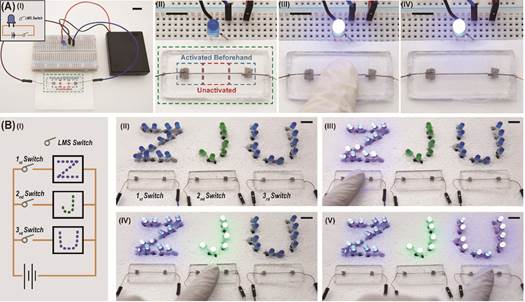Research team led by Prof. HE Yong from the Zhejiang University School of Mechanical Engineering recently fabricated all‐printed flexible and stretchable electronics by an integrated multi-material 3D printing process composed of direct ink writing (DIW) of sealing silicone elastomer and special LM-silicone (LMS) inks. The flexible electronics exhibit with excellent printability and good conductivity, significant electrical response to deformation, and great reliability. Their findings are published in the journal of Advanced Functional Materials.
In recent years, flexible and stretchable electronics have exhibited immense potential in wearable computing, human-machine interaction, and soft robotics. Among a diversity of soft and flexible materials, liquid metal (LM) has extensive applications thanks to its remarkable conductivity and intrinsic stretchability.
Circumscribed by its low viscosity and high surface tension, no simple way has yet been developed to print LM with high efficiency and resolution. Moreover, the salient fluidity of LM may well lead to leakage in the damaged area, thereby resulting in the failure of flexible devices. These limitations set up formidable barriers to manufacturing and applying LM-based flexible and stretchable electronics.
The solution of Prof. HE's team is the LMS ink, a concentrated mixture of LM microdroplets and silicone elastomer, which is featured by its superb printability for DIW printing. Although LMS is not initially conductive, it can be activated by pressing or freezing. Activated LMS possesses impressive conductivity, exceptional stretchability and a quick electrical response to strain. Owing to LMS's unique structure, LMS-embedded flexible electronics exhibit great damage mitigation, thus preventing the occurrence of leakage even when damaged. To demonstrate the flexibility of this process in fabricating LM-based flexible electronics, researchers printed multilayer soft circuits, strain sensors, and data gloves.

It is notably thanks to these distinctive assets of the LMS ink that flexible and stretchable electronics can be printed efficiently and precisely.






